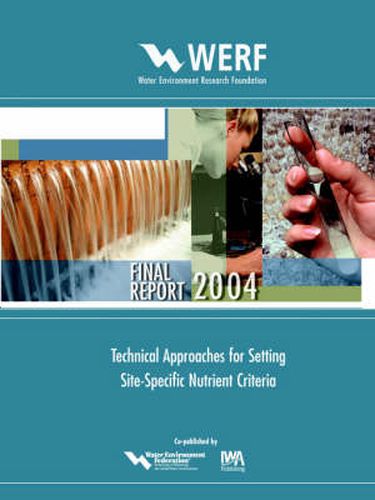Readings Newsletter
Become a Readings Member to make your shopping experience even easier.
Sign in or sign up for free!
You’re not far away from qualifying for FREE standard shipping within Australia
You’ve qualified for FREE standard shipping within Australia
The cart is loading…






The purpose of this project was to develop a methodology for deriving site-specific nutrient criteria (SSNC) for surface waters, including streams and rivers, lakes and reservoirs, and coastal estuaries. The methodology was developed to extend the United States Environmental Protection Agency’s regional nutrient criteria for localized conditions characterized by particular desired water quality requirements or designated uses. The proposed SSNC methodology provides local stakeholders with a recipe for estimating nutrient criteria consistent with site-specific water quality management goals and objectives. The SSNC methodology prescribes a three-tiered or sequential approach for defining concentrations of acceptable nutrients in relation to management goals and objectives. Each tier requires successively more site-specific data and information and also develops increasingly quantitative and technologically more detailed relationships between nutrients and stated water quality measurements (chlorophyll a, Secchi depth, dissolved oxygen). The SSNC process can be initiated at any tier, although most applications will likely progress from Tier 1. The derivation of Tier 1 SSNC relies extensively on existing data and regional nutrient criteria. Tier 2 adds additional, more site-specific data and estimates SSNC on the basis of statistical relationships between nutrients and the selected water quality parameters of interest. Tier 3 extends Tier 2 through the development of additional site-specific data and the application of site-specific, process-level water quality models to estimate the SSNC. Follow-up monitoring is a key component of all three tiers for assessing the effectiveness of the SSNC in achieving the desired water quality characteristics and making subsequent decisions about continued implementation or modification of the SSNC. Benefits: SSNC can serve as effective alternatives to regional criteria, which may fail to achieve or sustain locally desired water quality conditions.
The proposed methodology prescribes an efficient and economical approach for achieving site-specific water quality objectives.
The methodology develops SSNC on the basis of process-level understanding of relationships between nutrients and water quality objectives.
The tiered approach permits a sequential, increasingly detailed and sophisticated analysis of relations between nutrients and desired water quality conditions.
The results of the tiered SSNC methodology provide direct inputs to localized management and decision-making processes.
$9.00 standard shipping within Australia
FREE standard shipping within Australia for orders over $100.00
Express & International shipping calculated at checkout
The purpose of this project was to develop a methodology for deriving site-specific nutrient criteria (SSNC) for surface waters, including streams and rivers, lakes and reservoirs, and coastal estuaries. The methodology was developed to extend the United States Environmental Protection Agency’s regional nutrient criteria for localized conditions characterized by particular desired water quality requirements or designated uses. The proposed SSNC methodology provides local stakeholders with a recipe for estimating nutrient criteria consistent with site-specific water quality management goals and objectives. The SSNC methodology prescribes a three-tiered or sequential approach for defining concentrations of acceptable nutrients in relation to management goals and objectives. Each tier requires successively more site-specific data and information and also develops increasingly quantitative and technologically more detailed relationships between nutrients and stated water quality measurements (chlorophyll a, Secchi depth, dissolved oxygen). The SSNC process can be initiated at any tier, although most applications will likely progress from Tier 1. The derivation of Tier 1 SSNC relies extensively on existing data and regional nutrient criteria. Tier 2 adds additional, more site-specific data and estimates SSNC on the basis of statistical relationships between nutrients and the selected water quality parameters of interest. Tier 3 extends Tier 2 through the development of additional site-specific data and the application of site-specific, process-level water quality models to estimate the SSNC. Follow-up monitoring is a key component of all three tiers for assessing the effectiveness of the SSNC in achieving the desired water quality characteristics and making subsequent decisions about continued implementation or modification of the SSNC. Benefits: SSNC can serve as effective alternatives to regional criteria, which may fail to achieve or sustain locally desired water quality conditions.
The proposed methodology prescribes an efficient and economical approach for achieving site-specific water quality objectives.
The methodology develops SSNC on the basis of process-level understanding of relationships between nutrients and water quality objectives.
The tiered approach permits a sequential, increasingly detailed and sophisticated analysis of relations between nutrients and desired water quality conditions.
The results of the tiered SSNC methodology provide direct inputs to localized management and decision-making processes.